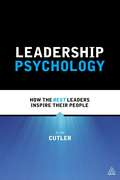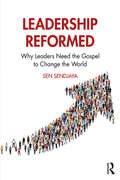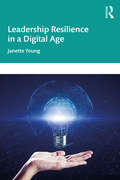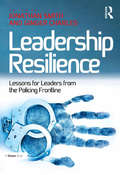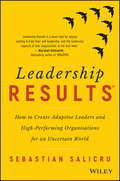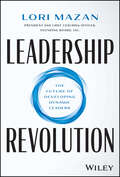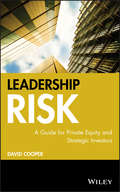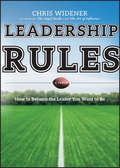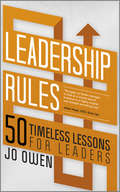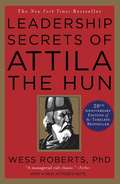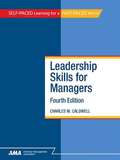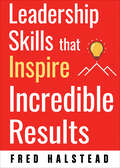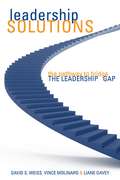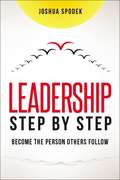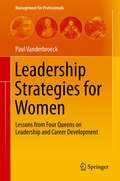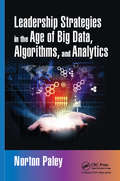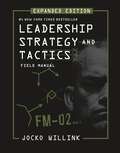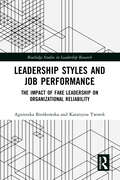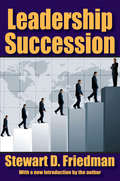- Table View
- List View
Leadership Psychology
by Alan CutlerA better understanding of the psychological relationships at play within current working environments will enable leaders to achieve greater success for themselves and their organizations. Leadership Psychology outlines how inspirational leaders across a range of award-winning companies of all sizes understand their employees' psychological needs and use that knowledge to affect behaviour and enhance performance. The book showcases examples of leadership best practice in businesses featured in The 2013 Sunday Times 100 Best Companies to Work for Survey. Exclusive information gained through interviews with the most highly regarded leaders of a special selection of these winning companies is analyzed and critically evaluated, using the underpinning principles of occupational psychology to reveal modern trends in working practice. This book provides up-to-the-minute practical guidance, based upon a rigorous psychological foundation, to executives holding operational or strategic leadership positions in businesses of all shapes and sizes.
Leadership Psychology: How the Best Leaders Inspire Their People
by Alan CutlerA better understanding of the psychological relationships at play within current working environments will enable leaders to achieve greater success for themselves and their organizations. Leadership Psychology outlines how inspirational leaders across a range of award-winning companies of all sizes understand their employees' psychological needs and use that knowledge to affect behaviour and enhance performance. The book showcases examples of leadership best practice in businesses featured in The Sunday Times 100 Best Companies to Work for Survey. Exclusive information gained through interviews with the most highly regarded leaders of a special selection of these winning companies is analyzed and critically evaluated, using the underpinning principles of occupational psychology to reveal modern trends in working practice. Leadership Psychology also includes unique information based on the author's discussions with military professionals at Sandhurst, sharing one-of-a-kind insights about what makes a strong leader under pressure. With updated looks at the unwritten 'psychological contract,' between employers and employees and a new analysis of Herzberg's motivational hygiene theory, Leadership Psychology is an original and timely addition to studies of leadership in the context of motivational factors.This book provides up-to-the-minute practical guidance, based upon a rigorous psychological foundation, to executives holding operational or strategic leadership positions in businesses of all shapes and sizes.
Leadership Reformed: Why Leaders Need the Gospel to Change the World (Routledge Frontiers of Business Management)
by Sen SendjayaThis book presents the gospel as a sensemaking tool to critically examine five areas of personal leadership effectiveness, namely desire, identity, dignity, motive, and ambition. Every tipping point in changing the world for the better always involves leadership. Yet history also illustrates that even formidable leaders are prone to derailment and failures. Contrary to the popular idea that leaders need to enhance their self-efficacy to be effective, the focus of self is misguided because the self is the epicenter of the leadership problem. The author posits that the preoccupation with the self (and consequently, unbelief in the gospel) is the fundamental reason why leaders are blinded by power and control, create their own performance treadmill, live for the approval of others, and have myopic ambitions for things of this world. Drawing on biblical insights and scholarly research, the leadership principles outlined in the book and their street-level applications will equip both novice and seasoned leaders to begin and end well.
Leadership Resilience in a Digital Age
by Janette YoungThe book focusses on the challenges faced in the digital age, and the increasing demands for continuous change in an inter-connected digital world. The book presents stories about how leaders have faced significant challenges and pressure, and how they have used these experiences as catalysts to transform, flourish, and develop personal resilience. The book explores the digital journey, ethical issues, teamwork, styles of leadership, agile, collaboration, trust, culture, psychological safety, self-awareness, vulnerability, conversation, positivity, emotional intelligence, creativity, inner knowing and the dark side of leadership. Drawing on the experiences of leaders in the creative, digital and technology sectors in the UK, and using their voice throughout, has resulted in proposing several internal and external strategic solutions to help the reader become more personally resilient. The book explores the impact of continuous change within a digital age, presenting the facets necessary to become a Digital Sage in an increasingly chaotic world. With a focus on creativity, innovation and mind and body awareness the leader as a Digital Sage arises to encourage resilience in a digital age. The book does not assume prior knowledge of the field of resilience and is ideal for executive education courses, and for leaders and managers seeking personal and professional transformation.
Leadership Resilience: Lessons for Leaders from the Policing Frontline
by Ginger CharlesLeadership is demanding and challenging. How do leaders cope? How do they remain fit and strong, and thrive? The authors of Leadership Resilience, a business school academic and a police officer, suggest that many challenges faced by leaders are similar to the challenges experienced by police officers. The isolation; the pressure not to show personal emotions; the expectation that they will deal effectively with confused, frustrated and angry people; and that they can deal with delivering bad news; all contribute to the pressures bearing on leaders and police officers everywhere. The authors argue that these challenges are more pronounced in policing and so more readily identifiable than in other leadership situations. They explore challenges experienced by police officers, look at how they cope with them, and draw lessons for those undertaking leadership roles more generally. Leadership Resilience provides accounts from police officers, in their own words, of difficult experiences they encounter. They describe their feelings about what was important and how they coped with it. Each account is followed by an analysis highlighting what is discussed, and not discussed, in the accounts and identifying lessons that can be drawn by leaders in other situations. All is presented so that it is relevant to different cultures demanding different styles of leadership. Analysis of the engaging experiences featured will help leaders struggling with the gap between leadership education and capability and the demands made of them to survive and thrive, while maintaining their physical, mental, emotional, and spiritual health.
Leadership Results: How to Create Adaptive Leaders and High-Performing Organisations for an Uncertain World
by Sebastian SalicruA model for developing the leaders and delivering the leadership results the world needs Leadership Results explores the fall of traditional leadership thinking and the struggling multibillion dollar leadership development industry that is failing to deliver results, and explains the mindset, skills, ways of being and methods that will get results in the new context and evolving paradigm. The Leadership Results model is practical and predictive, providing a way forward for companies seeking to build sustainable leadership capacity, develop individual leaders, boost employee engagement and deliver breakthrough results through shared and collective leadership. Actionable steps guide you through the process of evolving leadership culture to see increased productivity, growth opportunities and ensured profitability borne on a culture of trust, collaboration, fairness and a commitment to innovation and real prosperity. Expert analysis debunks pervasive myths and assumptions surrounding leadership, employee engagement, and talent development, while demystifying the role technology plays in innovation and progress. Leaders, coaches, trainers, OD practitioners, change agents, and students will find insightful guidance, thought-provoking discussion and illustrative case studies that will help them: Rethink leadership to make a stronger impact Take bold action to change the status quo Marry strategic and innovation leadership into a force for real change Stop making the same mistakes and start forging a new path forward From the heads of state on down, all levels of leadership are experiencing a rapid loss of trust and confidence — and the glaring absence of results that follows. Unethical business practices are costing more than five per cent of the global GDP every year; citizens around the world have lost faith in the public and private sectors; only 13% of employees are engaged at work — clearly, there is a severe lack of effective leadership. Leadership Results provides a practical way forward through this global quagmire, with a clear, actionable model for leadership that works.
Leadership Revolution: The Future of Developing Dynamic Leaders
by Lori MazanTransform the next generation of talent into capable and productive leaders In Leadership Revolution: The Future of Developing Dynamic Leaders, distinguished executive coach Lori Mazan delivers an exciting new approach to leadership development tailor-made for the 21st century. Drawing on lessons learned from coaching top executives for 25 years and from democratizing executive coaching by founding a cutting-edge scalable leadership coaching firm, you’ll learn how to attract and retain talent by accelerating and individualizing their professional growth and how to re-think leadership in the new remote and hybrid work environment. You’ll also discover how to help your staff flourish by relying on a sense of community and shared purpose, even when they’re working from a distance. The book includes: Concrete, hands-on strategies for becoming a leader who develops other leaders Ways to avoid the creation of a gap between the upper echelon of executives and high-potential managers and grow a diverse leadership pipeline Techniques for carefully considering a potential leader’s skills, experiences, and interests while moving them up the leadership ladder Deep understanding of how leadership coaching opens the door to breakthrough thinking and results How to move from the traditional focus on measuring activities to measuring and cultivating true developmental and organizational impactAn invaluable and practical strategy guide for leadership and talent development, Leadership Revolution is the perfect resource for managers, executives, coaches, and other business leaders looking for proven ways to shape the next generation of leaders in their firms.
Leadership Risk: A Guide for Private Equity and Strategic Investors
by David CooperThis book is a practical guide for private equity investors. It sets out a framework for understanding, assessing and managing the risks associated with senior management during the due diligence process of an acquisition. This provides an essential input into the wider due diligence review and a sound basis for managing the investment after the deal has been done so as to maximise the chances of a successful exit. The book comes at a time of significant growth in the field of private equity. In the UK over 3 million people (around 18% of all private sector employees) now work for private equity backed companies. It is estimated that European funds currently have somewhere between #200 and #300 billion to invest over the next few years. In the US, the whole issue of private equity due diligence is much more advanced but it is still likely that due diligence will remain a significant issue for private equity investors for the foreseeable future.
Leadership Roles Management Functions In Nursing: Theory And Application
by Carol Huston Marquis L.Now in its Fifth Edition, this foremost leadership and management text incorporates application with theory and emphasizes critical thinking, problem solving, and decision making. <P><P>More than 225 case studies and learning exercises promote critical thinking and interactive discussion. This edition includes 46 new case studies in settings such as acute care, ambulatory care, long-term care, and community health. <P><P>The book addresses timely nursing leadership and management issues, such as leadership development, staffing, delegation, ethics and law, organizational, political, and personal power, management and technology, and more. <P><P>Web links and learning exercises appear in each chapter. An Instructor's CD-ROM includes a testbank and PowerPoint slides.
Leadership Rules
by Chris WidenerAn inspiring business fable that champions leadership for the Everyman From bestselling author Chris Widener comes a compelling new story showing what you give and get when you lead. The story follows down-cast protagonist Mike Keller who, recently separated from his wife and demoted at work, must relocate to a rural factory-town in Texas. There, Mike encounters the deep-rooted traditions of Texas high school football, and in the process learns everything business school didn't teach him about leadership from the most influential man in town-the local high school football coach. Highlights the Four Rules of Leadership: You Get What You Expect, You Get What You Model, You Get What You Reward, and You Get What You Work For Advises readers, in an accessible teaching style, on how to tailor the Rules to their own circumstances Includes reflection questions as a tool to guide readers in enriching their work life, family relationships, and social interactions Leadership Rules is an engaging, refreshing tale that imparts leadership lessons easily applied to both work life and your interpersonal relationships.
Leadership Rules
by Jo OwenFrom the man behind the bestselling How to series comes more essential business wisdom. . . and this time, it's nicely broken up into 50 digestible nuggets. This is dip-in, dip-out content - easily read, understood and implemented and complete with engaging illustrations. There are a handful of truly inspired and inspirational leaders in the world - you know who they are. . . and probably wish you were one of them. But leadership isn't easy - some say it's an innate quality, a natural skill that only a select few demonstrate - but this thinking is nonsense, according Jo Owen. We can all become respected and effective leaders if we just follow some fundamental rules. Jo has studied what makes leaders effective everywhere - from the world's leading banks and management consultancies, to the world's oldest tribes in Africa. And he has distilled his observations into 50 practical rules that we can all follow and use to become the leaders we aspire to be.
Leadership Secrets of Attila the Hun
by Wess RobertsClassic insight for modern times.The world's foremost producer of personal development and motivational audio programs now offers a completely unique approach to learning leadership skills.Most programs on leadership present the successes of contemporary men and women as role models for study. While valuable lessons can be learned from their examples, few models or success stories reveal the true essence of their leadership abilities or can anticipate the special circumstances, conditions, or situations that you deal with as a manager.In the runaway bestseller Leadership Secrets Of Attila The Hun, author Wess Roberts draws from the imaginary thoughts of one of history's most effective and least beloved leaders, Attila the Hun, to discover leadership principles you can apply to your own situation. In a uniquely creative and entertaining approach to a most serious task, "Attila" reveals his principles for successful morale building, decision making, delegating and negotiating, and gives advice on overcoming setbacks and achieving goals.
Leadership Skills for Maintenance Supervisors and Managers
by Joel D. LevittSupervision is a leveraged activity. When we develop the supervisor's skills, we enhance the productivity of the whole workgroup. This book provides valuable skill training for supervisors, team leaders, and managers. It offers techniques to improve reliability that can be accomplished at the supervisor level. It teaches both the science and the art of the supervision of maintenance workers, discusses managing meetings and time, the elements of technical issues, and presents management and people skills, offering maximum productivity and high-quality provision of services and at the same time, improving morale throughout the workforce. This book is suitable for all types of maintenance for organizations with supervisors and managers from plant operations, storeroom, construction, and related areas including industrial organizations, construction companies, mines, fleets, building maintenance, janitorial maintenance contractors, and vocational tech schools teaching maintenance short courses.
Leadership Skills for Managers, Fourth Edition
by Charles M. CaldwellToday’s leaders face many challenges in achieving their goals. Rapid changes in technology, a more diverse workforce, changes in government regulations, worldwide competition, and the growing complexity of things in general have increased our awareness of the need for more effective leaders. Developing leaders requires having an understanding of the knowledge and skills required for effective leaders. Leadership Skills for Managers, 4th edition, focuses on five leadership skill sets necessary to ensure individual and organization performance: providing direction, leading by example, enabling others, sharing power, and seeking a better way. In addition to the leadership skill sets, the book examines the attitudes and mindsets of effective leaders. In the final analysis, the evidence of leadership is in the performance of the people and the organizations that follow the leader. When they perform well, the leader is a success. When they don’t perform well, leadership changes are almost always forthcoming. This book provides the background, real-world examples, practical applications, and numerous exercises to help prepare aspiring leaders. The lessons learned in this course can be applied to any leadership level in an organization and in any type of organization. Readers will learn how to: * Make the change from manager to leader. * Provide direction. * Enable others to achieve and succeed. * Develop a vision and create alignment. * Grow and develop new leaders. * Appraise leadership performance. * Use Continuous Improvement.
Leadership Skills that Inspire Incredible Results
by Fred HalsteadWhat do leaders and executives do to keep improving their performances and maintain momentum? They go back to the basics. Fundamentals are the glue—communicating, listening, questioning, inspiring followers, being accountable, and delegating. These essentials are the change agents for leaders with a desire to succeed.In Leadership Skills That Inspire Incredible Results Halstead gives readers the same advice, guidance, and techniques he offers his clients. He outlines the skills needed to be an effective leader and provides techniques augmented by real-world examples from companies that include Spotify, Clif Bar & Company, Honeywell, and Eileen Fisher. Learn how to: •Hone others' critical thinking through insightful powerful questions•Inspire followers•Fearlessly delegate with mindful purpose•Create a culture of accountabilityReaders will see how the development of these skills demonstrates respect for others that will inspire them to tackle goals and produce results previously thought impossible. It shows professionals at all levels how to improve these skills to create greater success for them, their team, and their entire organization.
Leadership Solutions
by Weiss David S. Vince Molinaro Liane DaveyAn organizational guide to assessing, measuring, and building leadership capacity Leadership capacity has emerged as a key source of competitive advantage in today's economy. But many organizations struggle to develop the capacity they need to succeed. This book offers concrete and precise strategies to close the leadership gap. It explains in detail how to conduct a leadership analysis, determining exactly where the gaps are in both organizational and individual leadership; analyzes the challenges a company faces; helps in understanding an organization's leadership deficit; and generates leadership solutions tailored to the organization's particular needs and shortcomings.
Leadership Standpoints: A Practical Framework for the Next Generation of Nonprofit Leaders (Elements in Public and Nonprofit Administration)
by Don WaisanenThis project offers a new leadership framework for the next generation of nonprofit professionals. Based on five years of data collected from the New York Community Trust Leadership Fellowship – designed to address leadership development gaps in the nonprofit sector – it constructs three dimensions and eleven themes for the theory and practice of leadership standpoints. Leadership standpoints is a framework for practicing inclusion, building spaces for performance, and thinking and acting with range. Those using leadership standpoints continuously interact with diverse stakeholders, constantly verifying others' views and interests, remaining keenly attentive to power distributions, material constraints, and hidden or unacknowledged voices that need surfaced, while expanding their personal and social outlooks to elevate performance and meet pressing demands best addressed through broadly informed decisions. I provide an overview of leadership standpoints as an aspirational, democratic, grounded form of leadership within everyone's reach.
Leadership Step by Step: Become the Person Others Follow
by Joshua SpodekDon&’t be content with simply learning what makes a great leader. Take the time to put in the work building those character traits inside you.Why is it that most of the principles and ideas we are inspired with when we read leadership books rarely end up leaving the page? Because we&’ve learned what successful leaders are doing, as well as why we should be implementing it ourselves, but we have no idea how we can specifically do all this in our unique circumstances.Leadership Step by Step walks you through what to do and how to do it by taking you through an integrated and comprehensive progression of exercises designed to cultivate key abilities, behaviors, and beliefs through experience.By the end of the 22 exercises in this hands-on book, you will learn to:Build self-awarenessManage emotionsSpeak in an authentic voiceCreate meaningful connectionsInspire othersEach chapter opens with a story demonstrating a vital leadership skill. Then, it guides you through the process of developing that skill for yourself.Leadership Step by Step teaches you how to be that leader you&’ve read so much about!
Leadership Strategies for Women
by Paul VanderbroeckHow do women leaders make it to the top of an organization? How can women stay at the top when most of their colleagues are men? What should women do to exercise leadership well? This book tells the stories of four powerful women who knew the answers to these three questions. Therefore, this book also explicitly identifies the key factors in these leaders' career success, and it elucidates the competencies that enabled the women to exercise leadership effectively. The four success stories offer women who already serve in leadership roles and those who aspire to become great leaders both inspiration and practical lessons that can be applied to real-world challenges. "A wonderful selection of much-needed role models of powerful women who shaped their time with distinctively authentic styles, all their own. An inspiration for both men and women of what more gender balance in global political and economic roles has to offer the world. " Avivah Wittenberg-Cox, CEO 20-first and best-selling author of Why Women Mean Business and How Women Mean Business. "We all know we can learn a lot from history. Leadership Strategies for Women does this in the unexpected context of gender diversity. Nicely written and original, the book is a powerful example of how looking back can help us moving forward. " Frank Uit de Weerd, Vice-President HR Innovation, Research & Development, Royal Dutch/Shell "An inspiring narrative that creatively leverages lessons from four women from the past, each of whom had to play the cards she was dealt, and each a force of nature who prevailed against the odds and shaped her world. Today's crop of aspiring women leaders, who often start from scratch and face a bewildering array of options and tough performance expectations, would do well to absorb this book's tightly drawn lessons. " Ingo Walter, Seymour Milstein Professor of Finance, Corporate Governance and Ethics, NYU Stern School of Business
Leadership Strategies in the Age of Big Data, Algorithms, and Analytics
by Norton PaleyHarnessing the power of technology is one of the key measures of effective leadership. Leadership Strategies in the Age of Big Data, Algorithms, and Analytics will help leaders think and act like strategists to maintain a leading-edge competitive advantage. Written by a leading expert in the field, this book provides new insights on how to successfully transition companies by aligning an organization’s culture to accept the benefits of digital technology. The author emphasizes the importance of creating a team spirit with employees to embrace the digital age and develop strategic business plans that pinpoint new markets for growth, strengthen customer relationships, and develop competitive strategies. Understanding how to deal with inconsistencies when facts generated by data analytics disagree with your own experience, intuition, and knowledge of the competitive situation is key to successful leadership.
Leadership Strategy and Tactics: Field Manual
by Jocko Willink#1 New York Times Bestseller #1 USA Today bestsellerThe ultimate guide on leadership from the bestselling co-author of Extreme Ownership.In the military, a field manual provides instructions in simple, clear, step-by-step language to help soldiers complete their mission. In the civilian sector, books offer information on everything from fixing a leaky faucet to developing an effective workout program to cooking a good steak. But what if you are promoted into a new position leading your former peers? What if you don’t get selected for the leadership position you wanted? How do you overcome imposter syndrome, when you aren’t sure you should be leading? As a leader, how do you judiciously dole out punishment? What about reward? How do you build trust with your both your superiors and your subordinates? How do you deliver truthful criticism up and down the chain of command in a tactful and positive way? These are all questions about leadership—the most complex of all human endeavors. And while there are books out there that provide solid leadership principles, books like Extreme Ownership and The Dichotomy of Leadership, there is no leadership field manual that provides a direct, situational, pragmatic how-to guide that anyone can instantly put to use. Until now. Leadership Strategy and Tactics explains how to take leadership theory, quickly translate that theory into applicable strategy, and then put leadership into action at a tactical level. This book is the solution that leaders at every level need—not just to understand the leadership game, but also how to play the leadership game, and win it.
Leadership Studies: A Narrative Inquiry (Elements in Leadership)
by Stan AmaladasBeginning with the belief that the study of leadership belongs to all and to no one in particular, the author offers 27 stable and unchanging elements for the study of leadership, and collects them under four themes: context, shared purpose, language, and human agency. He (a) argues that the rational interest in making our world a better place cuts across all academic disciplines/boundaries, (b) grounds the quest for an integrated theory of leadership in the Desire for Shared Agreement, and (c) offers the possibility that this Desire as a Governing Standard can potentially unite the multiple approaches to leadership studies.
Leadership Styles and Job Performance: The Impact of Fake Leadership on Organizational Reliability (Routledge Studies in Leadership Research)
by Katarzyna Tworek Agnieszka BieńkowskaVarious styles of leadership have the potential for positive and negative influence on employees and organization. The monograph offers a new approach and proposes the systematic analysis of negative leadership traits and behaviors through the broadening of existing approaches (based on employees’ orientation and organizational orientation) by analyzing them together with a third dimension: leader’s traits, which will allow us to analyze the intent of the leader. Based on this approach, the monograph introduces the term: fake leadership, characterized by an emphasis on individual goals of the leader (regardless of their importance for the organization) coupled with intentional anti-employees and anti-organizational behaviours. Such leaders operate with intent to engage in negative behaviors towards employees and organization, simultaneously aiming at hiding such intent. The monograph introduces and empirically verifies various models explaining the mechanisms, through which fake leadership negatively influences job performance of employees and organizational reliability based on intraorganizational trust and positive job-related attitudes (work motivation, job satisfaction, work engagement, organizational commitment), as well as negative job-related attitudes (work disengagement, job dissatisfaction, work demotivation), tend to hide errors, which is coupled with the number of management and employees’ errors. These models reference the concept of authentic leadership, which is chosen as a positive alternative to the described fake leadership.
Leadership Succession
by Stewart D. FriedmanThis volume focuses on the most critical strategic activity in any organization, namely, who gets chosen to sit in the top echelon of the pyramid. Friedman argues that it is the quality of corporate leadership that will determine corporate winners and losers in the global competitive game.The stakes in leadership succession are high. The selection of key figures is the one human resource activity that no one belittles for being of secondary importance. Indeed, leadership succession is so important and central in many executive minds that it crowds out any other work. The succession process is often fraught with political intrigue, it lacks discipline, and excludes meaningful involvement of senior human resource executives.The contributors to this imaginative volume reveal a succession planning process that is frequently sloppy, superficial, and regularly sabotaged by senior management when they give it short shrift in terms of quality time. In addition, senior management often overrides sound decisions when it comes to filling key positions. The result is a lack of integrity throughout the human resource systems that eventually leads to a collapse of belief in the system and its governance.Noel M. Tichy, a leading figure in the studies of human resource management, has said, ""Stewart Friedman is to be congratulated for a successful effort in providing a state of the art look at leadership succession. [He] provides us with an empirical database of what is happening in U.S. corporations, helpful prescriptions for future improvement of leadership succession, and a realistic assessment of the human resource executive challenges in this area.
Leadership Team Alignment: From Conflict to Collaboration
by Frédéric Godart Jacques NeatbyDebunking much of the received wisdom regarding the sources of leadership team dysfunctionality, Leadership Team Alignment presents a targeted strategy for building and managing a top executive team to gain competitive advantage. Frédéric Godart and Jacques Neatby bring a wealth of practical experience and in-depth knowledge, with over eight hundred hours of direct observation with more than fifty leadership teams across the globe and thousands of hours working with executives. With this book, they offer solutions to manage conflict and create environments that effectively address misalignments in organizations. Godart and Neatby take readers through the dual role of leadership team members, the challenges of power games, and the risks of siloed leaders. They give clear advice on how to improve aspects of any leadership team, based on its size and structure and the nature of the organization. While organizational challenges may be inevitable, this book provides leadership teams the tools to correctly diagnose leadership team misalignment, with evidence-based remedies and strategically oriented interventions to maximize organizational performance.
